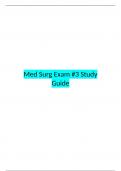Summary
Summary Med Surg Exam #3 Study Guide
- Course
- Institution
Med Surg Exam #3 Study Guide Med Surg Exam #3 Study Guide Alzheimer’s disease and the management; nursing care of the patient with Alzheimer’s What is it: AD is a progressive, irreversible degenerative neurologic disease that begins ...
[Show more]



